Improvement focused governance: guidance for non-executive directors
Resource booklet for NHSScotland board members with an interest in improvement governance.
The Improvement Focused Governance Cycle
The following cycle can be followed to support dialogue, planning and actions that promote the reliable implementation of improvement focused governance across NHSScotland.
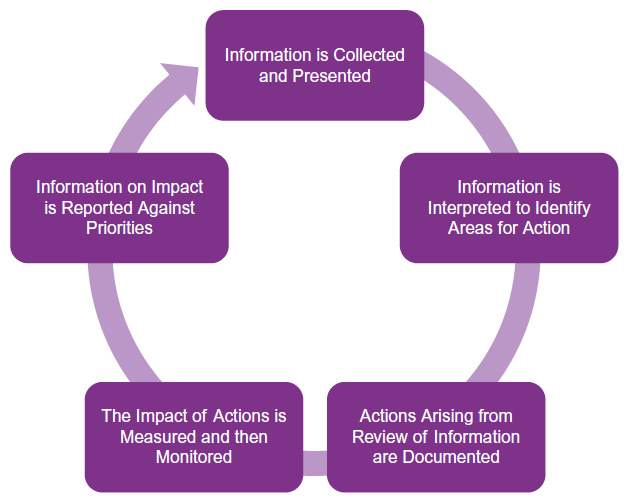
Each of these phases within the cycle support an improvement focused governance approach. Tips on how to retain an improvement focus throughout this cycle are outlined in the remaining sections of this booklet.
Considering the right information
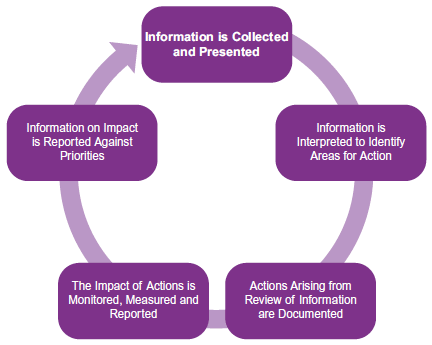
Improvement focused governance activity is only possible if the right information is being presented for review. Papers that progress through a series of stages before being considered by a Board or Board level committee should become progressively shorter in length as they make progress through and the information 'flows' through the system.
Non-Executive Directors should not be considering documents developed for other purposes/groups. Generally speaking a paper being considered by a Board level committee should be shorter and more condensed than a paper previously considered by a contributing Committee or an individual Directorate. The challenge often for an effective improvement focused governance system is to address the tensions between 'work and re-work' of papers and the need for non-duplicative reports to be submitted for a range of meetings; to provide appropriate checks and balances while minimising costs of producing papers and ensuring testing and improvements.
Too much information presented too close to the date of a meeting does not allow for assimilation of the details, preparation and identification of issues for reflection and dialogue.
"Recycled" reports (which may not contain the most up to date information or which haven't been revised to consider the purpose of presenting the report to more than one committee) are generally unhelpful. Improvement focused governance is better served by ensuring all reports clearly describe the specific aim in presenting the report content across different groups.
Improvement focused governance is best served when there is a balance of information presented in relation to the past and to the future.
If the right information is presented it needs to be the right amount of information to support interpretation of the issue being considered. Important detail on context should also be provided to support discussion, decision-making and any actions to be agreed.
Information presented should focus whenever possible on both process and outcome data - covering what is known about the contributors to variation and the implications of this for improvement focused action.
Information reports should be brief and present information using a combination of text as well as graphically/diagrammatically when possible.
While it is important to ensure that there is an appropriate balance of information on services and processes that are working/performing well, Non-Executive Directors should ensure that appropriate focus is given to understanding powerful and important opportunities for improvement that can be identified from system defects/failures. [3]
Data for dialogue
The guide "Quality Improvement and Measurement: What Non-Executive Directors need to know" highlights issues to be considered when reviewing data. As more NHSScotland staff becomes aware of quality improvement approaches to support change and improvement, questions may arise in relation to when information is to be considered for 'judgment' or 'improvement'.
It is important to understand the purpose that informed the collection of the data ( i.e. data collected for improvement will have different characteristics to that collected for submission to inform national statistics).
All data and information should support an improvement focused dialogue: assurance that there is good staff engagement in collecting data over time and across processes to support improvement can be as important as receiving assurance that data are showing a significant trend or shift in one outcome measure.
What Non-Executive Directors can do to ensure that the right information is collected and presented
- Support and encourage the presentation of timely information. This should also clearly outline why this is being presented and what decisions are required.
- Consider processes, outcomes and experiences when reviewing information - and if these are not presented then ask for this information.
- Communicate expectations that information is presented succinctly, with background information and in a way that reflects priorities for services and continuous improvement.
- Discourage the use of 'The Board noted the paper' or 'For information' items and encourage more detail on what it is that is to be noted and how the information being tabled relates to the requirement for any actions to support or enhance services.
Actions identified should be learning and 'celebration' focused as well as those focusing remediation and the need for improvement.
What 'lens' is needed to consider information?
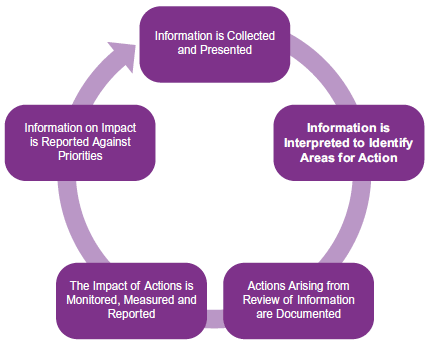
NHSScotland places quality of care at the centre of everything we do. Improvement focused governance is best facilitated by considering all information that is presented to Boards through this 'lens'.
Appendix 2 of the booklet in this series "Quality Improvement and Measurement. What Non Executive Directors Need to Know" covers key issues in measurement, understanding variation and data presentation that should be considered when reviewing information at this part in an improvement focused governance cycle.
The processes and reporting cycles for review of information being considered should be scheduled in advance and for any issues arising outside of this cycle, clearly agreed in advance.
Information should be considered from the perspectives of patients, service users and/or staff members. This can then support a conversation more focused on what matters to the people directly affected by the issues being considered. Actions can then be more effectively focused on what will be required to support improvement in the areas identified.
The booklet as part of this series on "Person-Centred Care" describes the way in which a person-centred 'lens' also be used to consider the ways in which services and thinking about service delivery are enhanced by focusing more on 'What matters to...' than 'What's the matter with...?' For example, a Board paper that collates information on future plans for people living with neurological conditions that makes no reference to considering what matters most to people may require an action to collect this information and identify changes and improvements needed.
Linking Governance Discussions
Information from other related governance conversations/processes may need to be considered when identifying what action to take - for example, a discussion in a Clinical Governance meeting might identify the need to support more doctors to develop skills in improvement science. This would raise the need to have a link with Staff Governance or Educational Governance process where additional work demands and training arising from the agreed action could be considered. Integrated governance meetings, frameworks and discussions can also help.
When interpreting information it can be important to focus on the process factors at play - as opposed to focusing solely on single examples, events or descriptions of a process at a single point in time).
Concentration on the 'whole' picture as opposed to selective parts often identifies areas where action will be required to support continuous improvement in quality or efficiency of services. This can be forgotten or overlooked when there is pressure to change or initial distress about the information and change processes.
It is important to remember that 'big' changes do not necessarily require 'big' action.
What Non-Executive Directors can do to ensure that information is interpreted to support the identification of actions
- Consider what will be required in terms of staff involvement, engagement and the related requirements to implement the action.
- Consider whether the voices and experiences of people who have direct experience of the services being considered (patients and staff) influence the discussion on actions required.
- Ensure that the actions that have been identified as necessary address the need to take actions that will change processes most likely to impact on outcomes and experience.
- Remember to consider the risk that actions are being formulated on the basis of 'noise' in the information being presented - if this is not clear, ask for the 'signal' and 'noise' issue to be explained.
Improving the Quality of Action Plans
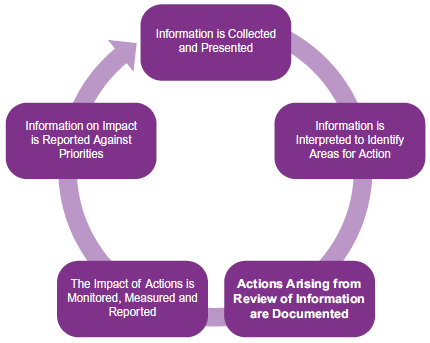
Governance processes and meetings often result in agreement of actions that need to be implemented to sustain, spread or implement continuous improvement. Actions must take account of the need to consider the impact on people, processes, outcomes and finances.
The development of an 'action plan' is often the response when a need for change, improvement or assurance has been identified. Governance and improvement meetings also often summarise the actions to be taken following consideration of the issue.
Improvement focused governance needs to make sure that the 'right' actions are identified, that these are described clearly and that links are made with measures that are sensitive to the changes that will be needed to monitor impact and outcomes.
Getting the right measure of progress is one of the most important actions that can arise from consideration of information presented.
Measures of Implementation AND Measures of Effectiveness
Clearly described actions need to be linked with measures of implementation and with measurement of effectiveness (Kaiser Permanente, 2016). Too much emphasis is often placed on measures of implementation - committee minutes or other documents being circulated.
A Measure of Implementation (MoI) is evidence that the action was implemented. It describes what was done to verify the action was instituted. However, it does not address the effectiveness of the measure.
A Measure of Effectiveness (MoE) provides evidence that the action was effective and has the desired impact. This can include monitoring of processes for an agreed period (possibly as part of an improvement programme) and reporting outcomes thereafter to the Board.
The following table outlines examples of Measures of Implementation and Measures of Effectiveness:
| Action |
Measure of Implementation |
Measure of Effectiveness |
|---|---|---|
| Increase staff numbers on evening shift |
Staff increased by one nurse on evenings is demonstrated on staffing sheet |
Improved transfer times due to additional staff member in evenings |
One Action, One Person
There needs to be clarity of responsibility for any actions arising from consideration of information presented through a governance process. Ideally there should be one owner responsible for implementation of the action outlined, ensuring that the efforts of the range of people involved with the action are coordinated and described succinctly for committee or Group members. This avoids diffusion of responsibility and related psychological factors that can blur lines of accountability.
Putting it all together…
Would you be able to summarise how the decisions made in a governance process support staff to deliver high quality outcomes, positive experiences or learning how to make things better? If not, how could this happen?
It can be useful to think about how decisions and actions reached collectively deliver strategic aims. This is sometimes referred to as a strategic narrative covering the range of work being undertaken in respect of quality, safe, effective, person-centred care, supporting the improvement of outcomes for the population served.
Being able to articulate a narrative that engages hearts and minds of staff and those receiving services will support an improvement focus to the actions agreed in support of improvement focused governance.
What Non-Executive Directors can do to ensure that the right actions are taken following consideration of information?
- Make sure that it is clear what action(s) have been agreed to determine what needs to be done, by whom and when? There should be one person responsible for leading and coordinating the work on the action.
- For all actions identified ensure that you have answers to the following questions:
- How will you know that the action agreed has been implemented?
- How will you know if the action has had any impact when it is implemented?
- Is the action strong enough to lead to change?
- Who is accountable for the delivery, monitoring and reporting of the progress and improvement against the actions agreed?
- Is it clear how actions will support the main strategic priorities of the Board?
Governance committees should have clearly described plans that consider how the operating effectiveness of a committee or governance process will be reviewed. This can be done by asking for feedback at the end of meetings or by the collection of responses to some key questions on the process of participating in the meeting.
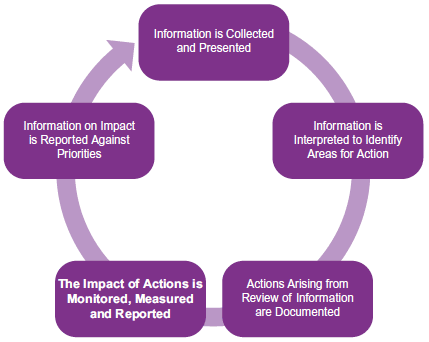
Measures of effectiveness from previously agreed actions should be considered when determining the impact. This ensures that progress is noted, learning from the work
is identified and that the links to other important strategic priorities can be emphasised.
The possible impact of actions on other parts of a system or process needs to be considered and, if necessary, actions agreed to monitor this and review as required.
What Non-Executive Directors can do to ensure that the right actions are taken following consideration of information?
- Make sure that you are presented with information that allows you to assess whether actions that have been identified previously have been effectively implemented. This will depend on there being an effective way of tracking the actions (including linked actions) that are identified.
- Monitoring engagement with stakeholders and how this has influenced actions and evaluation of the impact of actions on priority outcomes.
- Consider whether the actions taken have addressed the need to have a 'whole-system' focus.
The Board should consider the benefits of an integrated overview within and between Governance processes/committees. Non Executive Directors have a central role in identifying interdependencies across actions or any themes in respect of approach to change, culture, values, leadership or factors.
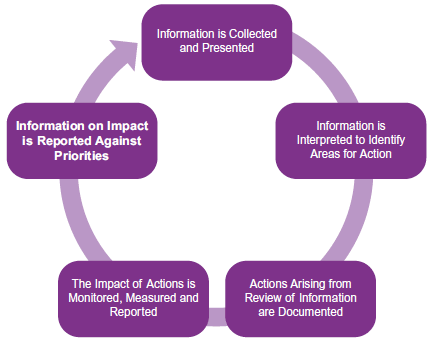
This could involve a review of themes in information being presented, actions being identified and processes that are being monitored. This could involve the monitoring of themes within the work of a committee.
For example, a Clinical Governance Committee (or equivalent) may consider a range of approaches being taken to improve patient safety and want to comment on the successes in staff engagement or leadership that they would like to encourage and support within another area.
An Information Governance Committee might have identified that resources are being mentioned as contributory to meeting statutory deadlines in both Health Records and Freedom of Information support services and ask for actions to be considered to develop and test a more efficient streamlined support process.
Information on impact will often be reported in dashboards. These need to reflect the priority areas of focus. If actions that have been identified to support improvement are aligned with outcome and experience data then these will rightly feature in the dashboards being presented, supporting dialogue about the impact of the actions that have previously been agreed.
The following dashboards illustrate the importance of considering whether the right measures, measured right, are being presented. In the first example (Figure 1) the right measures are available for the purpose involved (safely flying a plane):
Are the measures presented appropriately for purpose?
Figure 1 - Right Measures for Purpose

Figure 2 - Wrong Measures for Purpose
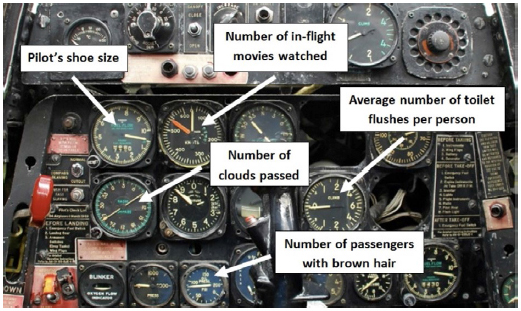
If the measures chosen are not relevant to the agreed purpose then problems will arise in being able to evaluate whether aims are being achieved and, in the worst case, can actually lead to poor decisions and increased risk. By illustration of this point, figure 2 shows a plane dashboard populated by the wrong measures.
It is also possible to measure the right things but in ways that are less useful (see Figure 3).
Consider the dials in the pictures above but presented in a manner that is less than helpful for the purpose:
Figure 3 - Right measures presented less usefully
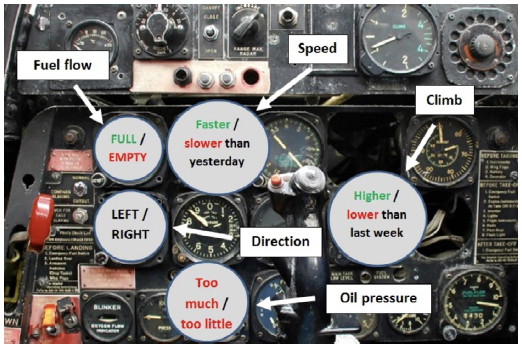
Source: https://inspguilfoyle.wordpress.com/2013/10/12/right-measures-measured-right/
Reprinted with permission.
What Non-Executive Directors can do to ensure that impact of previously agreed actions are reported against priorities
- Are there arrangements to record, track and identify progress against individual actions?
- Are the right measures being presented in the right way to determine the impact?
- How could evidence of effectiveness across strategically linked actions be collated and presented to evidence the improvement focus of governance processes?
For more information on the appropriate presentation of data please see the guide "Quality Improvement and Measurement: What Non-Executive Directors need to know".
Contact
There is a problem
Thanks for your feedback